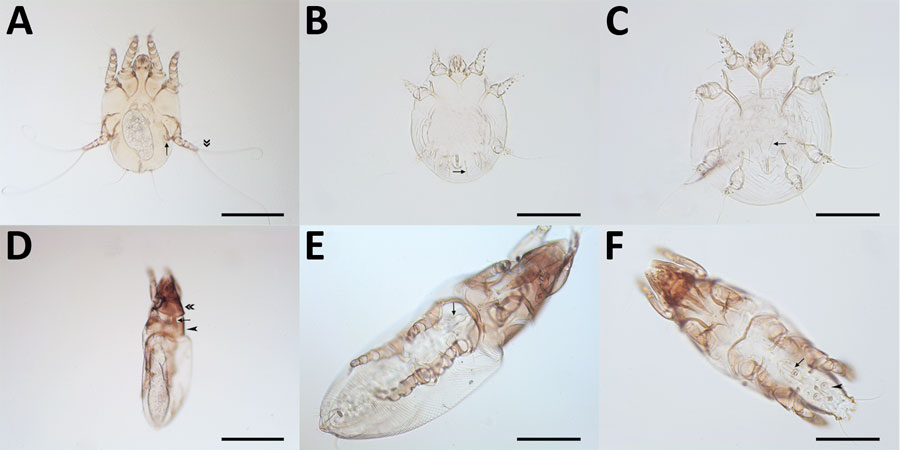Zoonotic Vectorborne Pathogens and Ectoparasites of Dogs and Cats in Eastern and Southeast Asia
Vito Colella

, Viet L. Nguyen, Do Y. Tan, Na Lu, Fang Fang, Yin Zhijuan, Jiangwei Wang, Xin Liu, Xinghui Chen, Junyan Dong, Wisnu Nurcahyo, Upik K. Hadi, Virginia Venturina, Kenneth B.Y. Tong, Yi-Lun Tsai, Piyanan Taweethavonsawat, Saruda Tiwananthagorn, Thong Q. Le, Khanh L. Bui, Malaika Watanabe, Puteri A.M.A. Rani, Giada Annoscia, Frédéric Beugnet, Domenico Otranto, and Lénaïg Halos
Author affiliations: University of Melbourne, Melbourne, Victoria, Australia (V. Colella); University of Bari, Bari, Italy (V. Colella, V.L. Nguyen, G. Annoscia, D. Otranto); Boehringer Ingelheim Animal Health, Lyon, France (D.Y. Tan, Na Lu, F. Beugnet, L. Halos); Guangxi University, Nanning, China (F. Fang); KangBao Pet Hospital, Guilin, China (Y. Zhijuan); Sapphire Veterinary Hospital, Shanghai, China (J. Wang); Meilianzhonghe Veterinary Referral Center, Beijing, China (X. Liu); Chongyisheng Veterinary Hospital, Chengdu, China (X. Chen); Nanjing Police Dog Research Institute, Nanjing, China (J. Dong); Gadjah Mada University, Yogyakata, Indonesia (W. Nurcahyo); Bogor University Indonesia, Jakarta, Indonesia (U.K. Hadi); Central Luzon State University, Nueva Ecija, Philippines (V. Venturina); Animal & Avian Veterinary Clinic, Yishun, Singapore (K.B.Y. Tong); National Pingtung University of Science and Technology, Pingtung, Taiwan (Y.L. Tsai); Chulalongkorn University, Bangkok, Thailand (P. Taweethavonsawat); Chiang Mai University, Chiang Mai, Thailand (S. Tiwananthagorn); Nong Lam University, Ho Chi Minh City, Vietnam (T.Q. Le); Vietnam National University of Agriculture, Hanoi, Vietnam (K.L. Bui); University Putra Malaysia, Selangor, Malaysia (M. Watanabe, P.A.M.A. Rani)
Main Article
Figure 5

Figure 5. Mites collected from dogs and cats in study of ectoparasites and vectorborne zoonotic pathogens of dogs and cats in Asia, 2017–2018. A) Otodectes cynotis female mite with greatly reduced last pair of legs (arrow); the third pair of legs terminates in 2 long and whip-like setae (double arrowhead). B) Sarcoptes scabiei male mite with strong and spine-like dorsal setae (arrow). C) Notoedres cati mite with narrow and not spine-like setae. D) Female Lynxacarus radovskyi cat fur mite with cylindrical and heavily striated idiosoma, well-developed head plate (double arrowhead) with convex posterior margin; propodosomal plate (arrowhead) with posterior margin broadly rounded, connected mediodorsally to head plate by a narrow-sclerotized band (arrow). E) L. radovskyi female mite genital apparatus (arrow) positioned between coxae III in female. F) L. radovskyi male mite with genital apparatus (arrow) positioned between coxae IV (arrow) and circular genital discs (arrowhead). Scale bars in panels A and D indicate 200 μm; scale bars in panels B, C, E, and F indicate 100 μm.
Main Article
Page created: May 18, 2020
Page updated: May 18, 2020
Page reviewed: May 18, 2020
The conclusions, findings, and opinions expressed by authors contributing to this journal do not necessarily reflect the official position of the U.S. Department of Health and Human Services, the Public Health Service, the Centers for Disease Control and Prevention, or the authors' affiliated institutions. Use of trade names is for identification only and does not imply endorsement by any of the groups named above.
